|
GEORGE ARTHUR REED 1874-1971.
Master Tailor, Yorkshire Hussar, Red Cross Auxiliary,
Scott-Trials Motorcyclist.
Readers of the Pocklington History Website will have noticed the section for ‘Sports’ showing how popular Cycle racing had become.
One particular news report titled ‘The Weighton Cycling Record’ featured the Cycle Racing from Market Weighton August 1895.
I noticed this report featured George Arthur Reed and his success in this event.
George Reed was aged 21 at the time.
Some years ago I studied the background to the Bus Services provided by the Everingham family and found George Reed had a connection with this family.
It transpired that his contemporaries Wycliffe, Irwin and Sidney Everingham were all keen supporters of Motor-cycling in Pocklington eventually opening a cycle shop in Railway Street about 1909.
However I did not know that George Reed had been such a keen Cyclist until I read the Pocklington History page on Sporting events, this called for further research about his long life.
George Reed was born in the village of Etton, East Yorkshire in January 1874
His father John Reed was a Stonemason; his mother Ellen was born at South Cave.
School education completed George took lodgings about 1889 at the house of a retired Police Sergeant in Market Weighton, whilst training to be a tailor in the town, very possibly with John Everingham
His life took on a relaxed air for a few years; however trouble in the Empire would test his Yorkshire character and resolve.
For in December 1899, the Government passed a warrant to create the Imperial Yeomanry, drawing on volunteers from every County.
This was in response to the declaration of Hostilities made by the Transvaal Republic and the neighbouring Orange Free State.
George was a suitable age being between 20 and 35, he was of good character, and met the appropriate Yeomanry standards of a horseman and marksman.
He decided to enlist for Military Service with the Yorkshire Hussars as part of the Imperial Yeomanry.
Within 24 hours there were more than 150 volunteers from Yorkshire.
The Government would supply Guns, Ammunition, Camping gear, and Transport to South Africa.
Volunteers like George had to acquire a Horse with Saddlery.
A capital grant was given for this, He retained this first Horse for the whole period of action in South Africa (the fact of which made him justly proud)
He was expected to provide his own Clothing (no problem there!).
Dress was in Norfolk jacket, Breeches, Gaiters, Laced Boots and Felt Hat. George must have struck an imposing figure on his Horse, quite a change from a Cycle!
He became Trooper G. A. Reed; 26177 of the Yorkshire Hussars, and he was placed in the 9th Company, (122) men of the Third Battalion,
These groups were amongst the first troops to leave England for the Cape from Liverpool, along with 450 Horses setting sail in late January 1900 aboard SS. “Winifredian”.
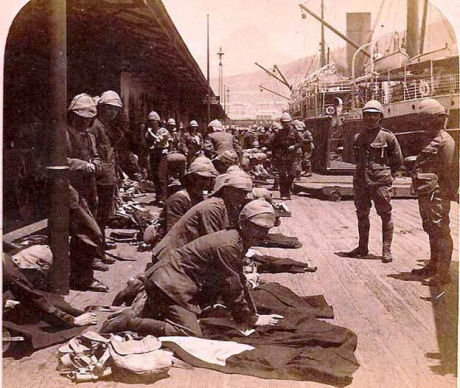
Yorkshire troops disembark at Cape Town (Brian Hull Collection)
A camp was situated near the Cape so further training was undertaken until other forces arrived from England.
The Yorkshire contingents of the Hussars saw action across Cape Colony, Orange Free State, and Transvaal.
An attempt to relieve Mafeking was rebuffed by the Boers, one report in The Times states that Men of the Yorkshire Dragoons and Yorkshire Hussars deserved much praise for their valiant action.
It was also reported that the Yorkshire Hussars distinguished themselves whilst losing heavily defending a rearguard action.
(Anyone reader interested in the action of the Yorkshire Hussars further, outside the scope of this work, will find references in the list of Acknowledgements).
Suffice to say that an injured soldier reported home that the Yorkshire Hussars had seen much fierce action for the short period of time they had been in the field.
(He had witnessed them under shell fire from the Boers), He stated that the Yorkshire Hussars had lost upwards of half their original strength, due to illness, injuries, death and being taken prisoner.
The period of Service for Volunteers was a minimum12 months, at the end of this period George would be eligible to return home.
Statistics show he had been fortunate for of the 122 men in his Company many did not to return. (Approximately 55 had been lost)
On his return journey their vessel the Mongolian even encountered difficulties at the Equator, and some repairs had to be made to the ship by members of the Volunteer forces in order that the vessel could complete its voyage home.
I believe George would have been awarded at least two Queens Medals for his South Africa Service.
Upon his return to Yorkshire in 1901 he must have felt lucky to be alive and fit enough to work again.
He resolved to further his training as a Tailor and Cutter, taking up a position as a trainee at Burberry’s Tailoring in London.
Over a two to three year period he studied at a Polytechnic in addition to his work at Burberry’s where he gained Top Class Honours according to his Nephew.
He produced clothes for several famous people including members of the Churchill Family and the Queen of Spain (who I presume was Queen Isabella II).
After working at Burberrys’ for several years he decided to strike out on his own account.
To accomplish this he acquired a three storey building at Blake Street, York, about 1905.
Back in1902 the lure of Motorcycling took hold and he purchased a Minerva machine and went touring abroad during 1903.
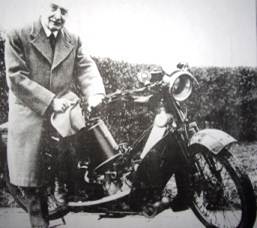
Photo Courtesy VMCC Archive
George Reed with his famous Scott Motorcycle
He remained in York until his retirement running a highly successful business providing Bespoke Tailoring services at his Gentleman’s Outfitters
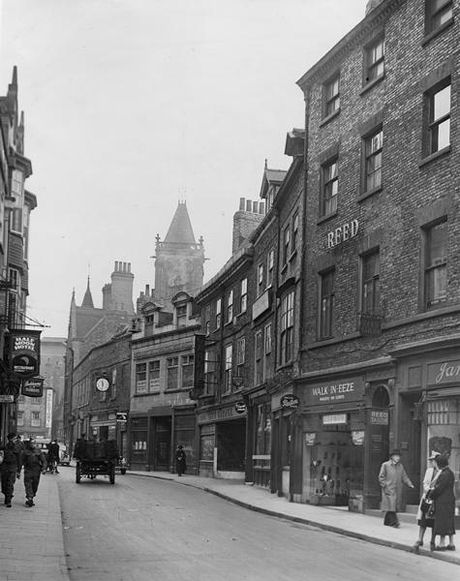
George Reeds Tailoring & Outfitters Shop, Blake Street, York.
by kind permission of the Northern Echo
His passion for Motorcycling led him to experiment, testing out several makes in regard to performance and innovation.
He tried out and evaluated modified parts from accessory makers, reporting his views to other motorcyclists.
He attended the Isle of Man circuit on many occasions.
George’s nephew recalls him having an early Motorcycle licence in York City about 1906.
His favourite Motorcycle make was Scott.
Based in Shipley, the Scott business was for a short period connected with Jowett Brothers who built some Frames for Scott machines until a larger premises was obtained
George struck up a friendly relationship with the founder Alfred Scott trialling machines for the firm.
In 1911 George acquired his own Scott model.
His interest in the development of these machines led him to try various other makes
This is a short synopsis of some of his purchases;
1911 a Scott, Used for private and Trade’ so perhaps he delivered collected cloth with a carrying device attached!
Next a Swiss model ‘MotoReve’ Twin lightweight (85 lbs),
A second Scott Machine followed by a ‘Rudge’ model
Next a ‘Coulson model ‘B’
Then a 500cc Scott model.
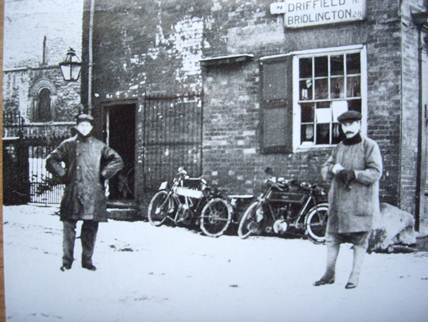 George with Irwin Everingham George with Irwin Everingham
(I C Gibbs Collection 2004).
In this picture the left hand motorcycle shown is a Cleckheaton built by Phelon & Moore.
He went on to win several Cups for his skill in trials on his Motorcycle including a 24 hour Bradford –London run.
At the beginning of the 1914-1918 conflict George was 40 years old.
Hostilities in Europe erupted so again George wished to provide useful role fir his country.
He joined the Yorkshire Regiment as a messenger with the York St Johns Motor Ambulances using a modified Motorcycle for conveying Military and Civilian cases.
The Red Cross centre of Operations in York City was administered from the York Assembly Rooms in Blake Street, just a few yards from the location of George Reed’s own tailors shop!
His record with the Red Cross informs us that he served with the West Riding/31 Detachment. (I believe these detachments have the epithet VAD)
He was a Private, classed as Despatch Rider and was enrolled in June 1916
His total hours of service stood at 2150, he served with the Society until August 1919.
He was awarded a Red Cross War Service Medal. (See illustration of this medal type).
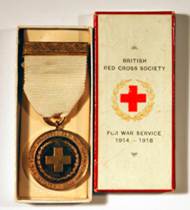
British Red Cross War Service Medal / Courtesy B R C Archive
He came through this voluntary service without injury to return to his Tailoring Business and his beloved Motorcycling.
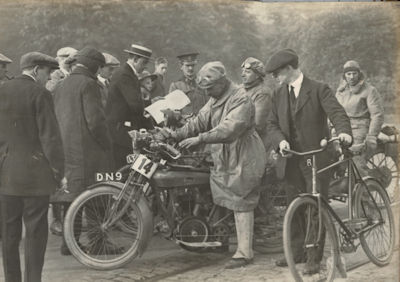 In 1919 he took part in the London to Edinburgh trial. This photograph shows G.A. Reed checking in at York on Saturday 7th June 1919. In 1919 he took part in the London to Edinburgh trial. This photograph shows G.A. Reed checking in at York on Saturday 7th June 1919.
He purchased a new model of 2-speed Scott this had drip-feed lubrication from oil the pump. He registered this Motorcycle in York as DN 9.
George Reed entered his 3 3/4 Hp Motor Cycle into the Scott Trials of 1922, travelling from Bradford to London and back on the 29th and 30th of July.
At this time he was a member of the Bradford Motor Cycle and Light Car Club, when he undertook this 24-hour Reliability Trial. (of both Man and Machine I expect!). His nephew still owns the Cup he was awarded.
When he entered for the Edinburgh to London Trials; his nephew recalls his winning some six Medals in consecutive years for that Event.
George became a member of the VMCC Club for the North East Area, to whom he bequeathed his 1919-20 Scott Machine for posterity.
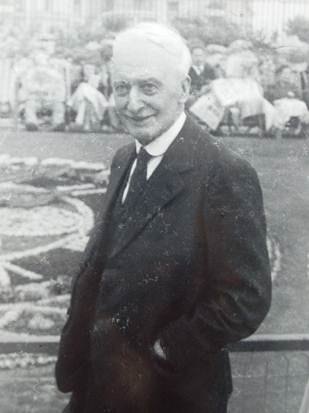
George Reed age 82 Bridlington 1957 (Courtesy D Everingham)
In October 1971 George passed away aged 97, his Motorcycle lives on cared for at the VMCC Museum.
It is still in used for special events by a chosen rider/member, a tribute to the quality engineering produced by Alfred Scott.
In closing this short biography of George Arthur Reed I must acknowledge the assistance of several individuals who graciously offered advice and pictures.
George’s nephew provided the correction and amplification of my notes, (and his patience), in replying to my several calls also that photograph taken in Bridlington in 1957 with Georges own Camera!
The VMCC Archive for help with articles pictures from their files.
The Archives / Library at York: (Sonia Murray-Kydd and Joy Cann), for searching various Tax Registers for me.
The Red Cross Archives (Emily Oldfield) for the details of George Reed’s War Service 1916-1919, also the picture of Red Cross War Service badge.
Brian Hull Collection, Parlington, for the Cape Town Illustration.
Hussards’ Photos Website UK; Yorkshire Hussars 1900-02 this gives further notes of their actions during the conflict.
This site is highly recommended for further reading of the Yorkshire Troops activities in South Africa in the Boer War.
© Ian C Gibbs.
Baildon
December 2010
|

